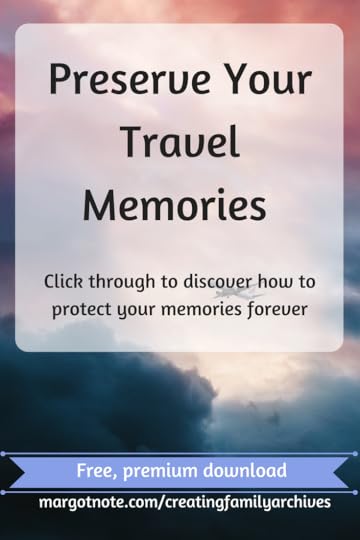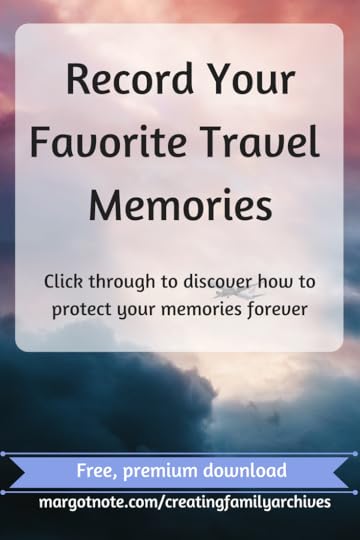Margot Note's Blog, page 42
March 18, 2018
Letter #19: Work Straightened Out
I'm continuing my series of scanning, transcribing, and annotating my grandfather's love letters to my grandmother leading up to their marriage in June 1940. The letters are chronologically organized and preserved, using the methods I discuss in detail in my book, Creating Family Archives: How to Preserve Your Papers and Photographs.
In Letter 19 of the Grandpa's Love Letter series, Grandpa is getting things done! The way he talks about work is similar to how I think about it. As an archives and records management consultant, I love creating order out of chaos. For me, that usually means advising clients on improving how their information flows throughout its lifecycle. For Grandpa, that means streamlining the creation of garments.
The way he describes the system of garment manufacturing and how it should be improved makes me realize that he is a process-driven thinker, like myself. He could think through a process from start to finish and improve it so that each step added the most value with the minimal amount of work. That's what I do for a living as well! Frankly, I never felt very close to Grandpa, but discovering this about him made me feel like a part of him lives on in me.
Here's one of my favorite pictures of him at work. Who took this picture? It's in a large format (8 x 10), so I wonder if it was a professional office shot?
[image error]
On the back, "1943" is written in pencil.
I love when Grandpa mentions cultural references; his comments give me some clues to research. He wrote about Comerford Theater in a previous letter. At the moves, he saw I Take This Woman, a 1940 drama starring Spencer Tracy and Hedy Lamarr.
Looking at old newspapers, I found an ad for Dr. R. Loewit, an optometrist at 18 Church Street in Paterson, New Jersey.
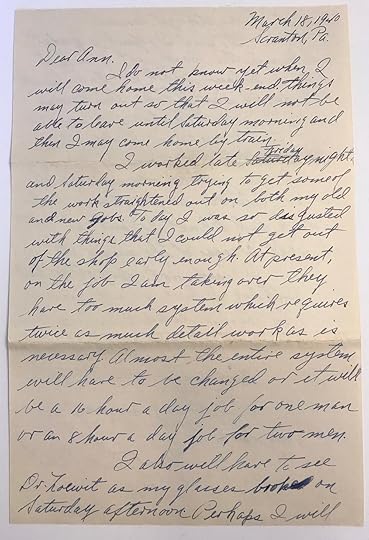
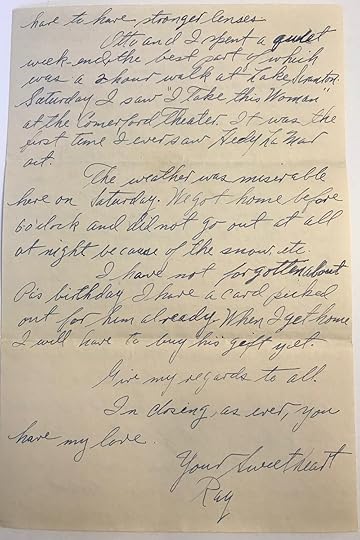
***
March 18, 1940
Scranton, Pa.
Dear Ann,
I do not know yet when I will come home this week-end. Things may turn out so that I will not be able to leave until Saturday morning and then I may come home by train.
I worked late Friday night and Saturday morning trying to get some of the work straightened out on both my old and new jobs. Today I was so disgusted with things that I could not get out of the shop early enough. At present, on the job I am taking over they have too much system which requires twice as much detail work as is necessary. Almost the entire system will have to be changed or it will be a 16 hour day job for one man or an 8 hour a day job for two men.
I also will have to see Dr. Loewit as my glasses broke on Saturday afternoon. Perhaps I will have to have stronger lenses.
Otto and I spent a quiet week-end, the best part of which was a 2 hour walk at Lake Scranton. Saturday I saw "I Take this Woman" at the Comerford Theater. It was the first time I ever saw Hedy LaMar [sic] out.
The weather was miserable on Saturday. We got home before 6 o'clock and did not go out at all at night because of the snow, etc.
I have not forgotten about Pa's birthday. I have a card picked out for him already. When I get home I will have to buy his gift yet.
Give my regards to all.
In closing, as ever you have my love.
Your Sweetheart
Ray
***
To learn the preservation secrets used by libraries, archives, and museums to protect their priceless materials (that you can also use for your family heritage items), read my book:
Creating Family Archives: How to Preserve Your Papers and Photographs
By Margot Note
If you like archives, memory, and legacy as much as I do, you might consider signing up for my email list. Every few weeks I send out a newsletter with new articles and exclusive content for readers. It’s basically my way of keeping in touch with you and letting you know what’s going on. Your information is protected and I never spam.
Ready to get started creating your family archives? Here are some of my favorite products:
Follow me on Pinterest | Instagram | Twitter | LinkedIn | Facebook

March 15, 2018
Letter #18: Succeed With My New Job
I'm continuing my series of scanning, transcribing, and annotating my grandfather's love letters to my grandmother leading up to their marriage in June 1940. The letters are chronologically organized and preserved, using the methods I discuss in detail in my book,
In Letter 18 of the Grandpa's Love Letters series, Grandpa is stuck in Scranton for the weekend. He seems very focused on his job and has got a recent promotion.
What does Grandpa mean by Green Ridge?
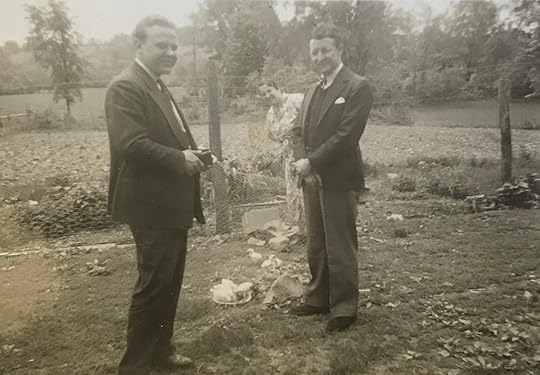
Grandpa with unidentified people
I chose this picture of my grandfather because he looks happy. Was my Grandma taking the picture? The picture is small: about 2 inches by 3 inches and the lighting isn't the best. It was only when I digitized it (or, let's be honest here, took a picture of it with my iPhone camera), that I saw that there was a woman in the background and baby chicks on the ground. I thought the baby chicks were appropriate for a letter about not missing Easter.
What I've enjoyed about this is project is how I'm posting the letters in real time. It's fun to look forward to Easter, which was a very important holiday from my grandparents. I loved the Easter Egg hunt (at home and at their house), the Easter baskets, and the big meal.
My mother sewed me Easter outfits that ranged from the cute to slightly insane. I loved the fashion illustrations on Butterick and McCall's patterns--which always looked chicer than the real-life result.
We would have Easter Egg battles. My grandmother would hard boil eggs, then dye them with onion skins to give them a bright reddish hue. You would then pair up with other people and try to crack your opponent's egg without cracking your own. The one that survived had good luck for the year. Grandpa always won!
This seems like a common Central and Eastern European custom. My grandmother was Lithuanian, but I've read about similar practices in many different countries.
Do you have an Egg Fight tradition? I'd love to hear about it in the comments!
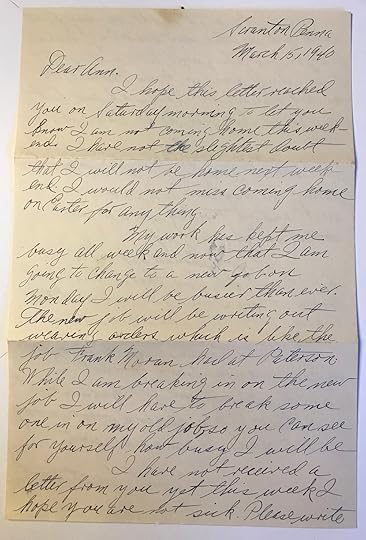

***
Scranton Penna
March 15, 1940
Dear Ann.
I hope this letter reached you on Saturday morning to let you know I am not coming home this weekend. I have not the slightest doubt that I will not be home next weekend. I would not miss coming home on Easter for anything.
M work has kept me busy all week and now that I am going to change to a new job on Monday I will be busier than ever. The new job will be writing out weaving orders which is like the job Frank Moran had at Paterson. While I am breaking in on the new job I will have to break someone in on my old job, so you can see for yourself how busy I will be.
I have not received a letter from you this week I hope you are not sick. Please write.
Since it will be my first week-end in this new boarding home I hope everything will turn out better than I was in Green Ridge. Otto is also staying here this week-end but his cousin left for home this afternoon.
We are having some more miserable weather here again. It rained Thursday during the day-time and snowed at night and on Friday morning and now it is freezing up.
If Joe should ask what I have to say, tell him that I have not looked at my stamps all week but that I may look them over on Sunday.
In closing please remember me in your prayers and pray that I succeed with my new job because if I do then I can demand more money for our needs. I remain as ever,
Your Sweetheart
Ray
***
To learn the preservation secrets used by libraries, archives, and museums to protect their priceless materials (that you can also use for your family heritage items), read my book:
Creating Family Archives: How to Preserve Your Papers and Photographs
By Margot Note
If you like archives, memory, and legacy as much as I do, you might consider signing up for my email list. Every few weeks I send out a newsletter with new articles and exclusive content for readers. It’s basically my way of keeping in touch with you and letting you know what’s going on. Your information is protected and I never spam.
Ready to get started creating your family archives? Here are some of my favorite products:
Follow me on Pinterest | Instagram | Twitter | LinkedIn | Facebook
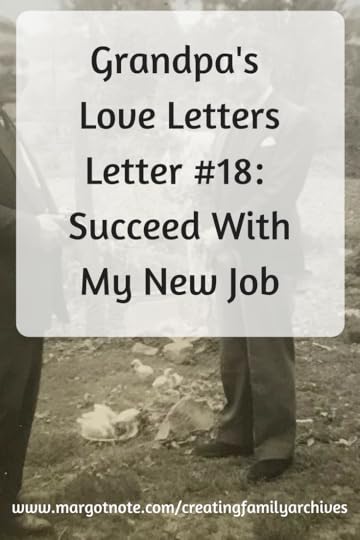
March 12, 2018
Letter #17: Took Some Work Home
I'm continuing my series of scanning, transcribing, and annotating my grandfather's love letters to my grandmother leading up to their marriage in June 1940. The letters are chronologically organized and preserved, using the methods I discuss in detail in my book,
The 17th letter in the Grandpa's Love Letters series discusses work and, of course, travel plans for the upcoming weekend.
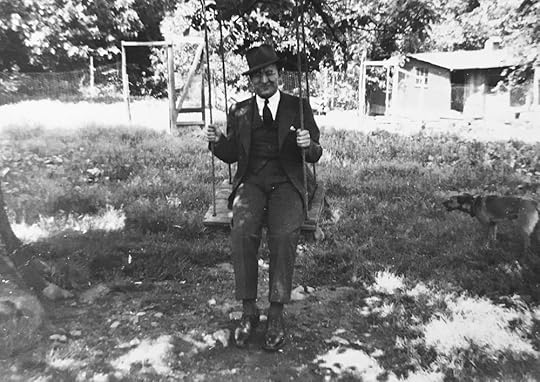
A picture ripped from my Grandma's scrapbook. I'm assuming this was from the late 1930s in Paterson, NJ.
I have a copy of my grandfather's resume from the mid-1950s. It's been helpful in providing some context to these letters. From his resume, Grandpa lists this experience from this period in his life:
Samuel J. Aronsohn & Sons, Inc.
183 Madison Avenue
New York, New York
Manufacturers of Silk and Rayon Dress and Tie Fabrics
From July 1, 1926 to April 1943
Employed at Paterson, N.J. Plant and Scranton, Pa., Plant
Positions held while in the employ of the above concern:
Floor Hand, Cloth Inspector, Sample Clerk, Stock Clerk, Production Clerk, Order Clerk, Production Supervisor and Expeditor.
Grandpa was 14 when he started working at the factory. He finished 8th grade, and then took a year of night school at the local high school on Business English. He took nine years of night school at the Paterson Vocational School on Cloth Dissecting and Analyzing, Cloth Calculation, Designing: Shaft and Jacquard, and Traffic Management: Basic and Advanced. He also took a 1-year Advanced Rayon course at Columbia University (!).

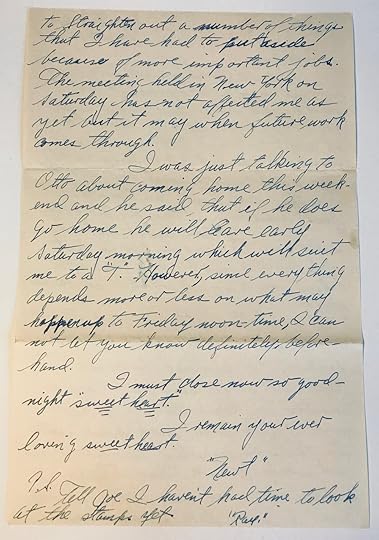
***
March 12, 1940
Scranton Pa.
Dear Ann,
Although we got here early Sunday night after a pleasant ride I would much rather have stayed with you longer, before leaving. We got here at about 7.45 and Otto came in at about 8.45, he had left Paterson on the 4:32 o'clock train. As usual Fred brought something along to eat. This time was a special occasion as it was his birthday.
It was decided that we would keep the same routine as last week therefore I still have the single bed and room to myself which I am rather glad of.
The weather is much colder than it was for the past few weeks. However, the sun has been out for two full days now and it has not snowed in these two days. Last night I took some work home with me that was important therefore I did not write to you then. If things go as they have been going for the past two days I will have a good chance to Straighten out a number of things that I have had to put aside because of more important jobs. The meeting held in New York on Saturday has not affected me as yet but it may when future work comes through.
I was just talking to Otto about coming home this weekend and he said that if he does go home he will leave early Saturday morning which will suit me a "T." However, since everything depends more or less on what may happen up to Friday noon-time, I can not let you know definitely beforehand.
I must close not so good night "sweet heart."
I remain your ever loving sweet heart
"Newt"
PS. Tell Joe I haven't had time to look at the stamps yet.
"Ray."
***
To learn the preservation secrets used by libraries, archives, and museums to protect their priceless materials (that you can also use for your family heritage items), read my book:
Creating Family Archives: How to Preserve Your Papers and Photographs
By Margot Note
If you like archives, memory, and legacy as much as I do, you might consider signing up for my email list. Every few weeks I send out a newsletter with new articles and exclusive content for readers. It’s basically my way of keeping in touch with you and letting you know what’s going on. Your information is protected and I never spam.
Ready to get started creating your family archives? Here are some of my favorite products:
Follow me on Pinterest | Instagram | Twitter | LinkedIn | Facebook

How to Avoid Plagiarism
Plagiarism is the practice of falsely representing as one’s own any language, thoughts, ideas, designs, or expression in a paper, exam, or other work. In short, it means taking someone’s else’s work and passing it off as yours. There are severe consequences for plagiarism in your academic, work, and personal lives.
Plagiarism may take many forms. Here are some of the more comment forms that occur in an academic setting:
Copying words or ideas from printed or online sources without citing the sources properlyCopying all or part of another student’s work and passing it off as yoursBuying essays or papers from others and passing them off as your ownWhat I’ve discovered as an instructor is that there are fewer students who plagiarize purposely. Instead, many students inadvertently plagiarize out of laziness or ignorance. Most of us learn about how to cite and how not to plagiarize in middle school and high school. Most colleges assume that you already know how to cite your sources; grad school definitely assumes that you know. Unfortunately, many students’ knowledge in this critical area of scholarly work is spotty. The rigors of academic work can cause students to slip a bit in their citations, assuming that no one will notice. Or they are working so quickly that they don't remember what idea came from where. Students not only cheat themselves out of the benefits of their education, but they also set themselves up for a lot of trouble. Professors such as myself try to put the fear of God into our students to help them avoid this unnecessary heartache!
What Do You Need to Cite?When you use someone else’s words and phrases in your work, you must enclose them in quotation marks and give the writer credit by citing your source. For instructors, it is easy to identify writing styles that don’t sound like the rest of your work.
When you use someone else’s ideas or original research in your work, you must cite the source. In this case, paraphrase. When you paraphrase, you restate someone else’s ideas in your own words. Although the words are your own, the ideas aren’t, so you still need to cite them. When you're in doubt, cite.
Keep careful notes as you do research, including where ideas came from so that you can easily cite the material in your paper. I cannot emphasize this enough; the minute it takes to record your citation will save you minutes and hours later on. Be kind to your future self and take good notes in the present.
Also read and understand your school’s academic integrity policy, as well as your instructors' policies if they have them. Ensure that you are not inadvertently doing something that would cause concern with your work.
What Don’t You Need to Cite?If the piece of information you want to use is considered common knowledge, you do not have to cite it. Will an average reader accept the statement as reliable without having to look it up?
To decide whether information could be considered common knowledge, ask yourself the following questions
Who is my audience?What can I assume they already know?Will I be asked where I obtained my information?Information that most people know or are shared by members of a certain field or cultural or national group is considered common knowledge. If you are writing to an audience outside of these groups, the information may not be deemed common knowledge.
If you have questions about if something is regarded as common knowledge in your field, ask your instructor.
Follow me on Pinterest | Instagram | Twitter | LinkedIn |
Like this post? Never miss an update when you sign up for my newsletter:
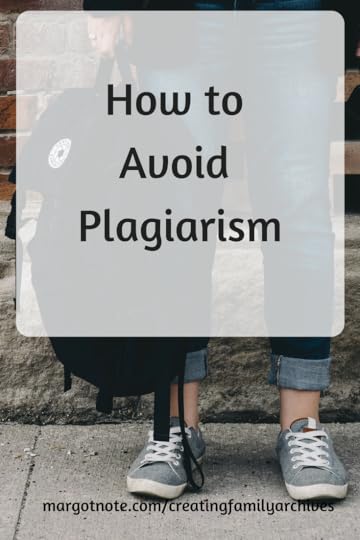
March 7, 2018
Letter #16: Make It Bearable
I'm continuing my series of scanning, transcribing, and annotating my grandfather's love letters to my grandmother leading up to their marriage in June 1940. The letters are chronologically organized and preserved, using the methods I discuss in detail in my book, Creating Family Archives: How to Preserve Your Papers and Photographs.
In the 16th letter, Grandpa mentions his family. He asks Grandma if she visited his sister, Lena, recently and asks about his father's health.
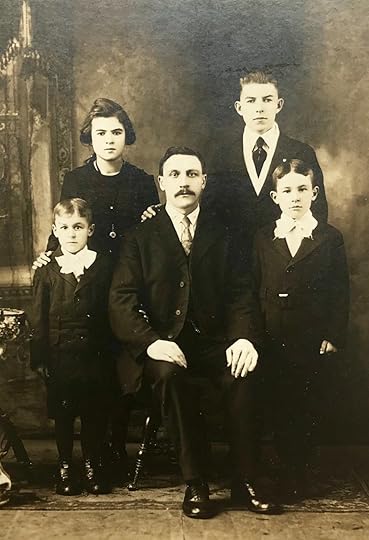
Detail from cabinet card
This detail from a cabinet card shows in the back Lena and Emil. In the front is my grandfather (Renee, later changed to Ray), his father Adolph, and his brother Charles. Guessing from my grandfather's age and the style of the clothing, I date this photograph at about 1920. It was taken at J. Porzio's Studio at 235 River Street in Paterson, New Jersey.
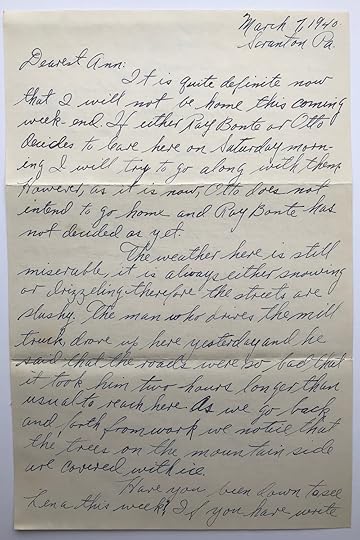

***
March 7, 1940
Scranton Pa.
Dearest Ann,
It is quite definite now that I will not be home this coming week-end. If either Ray Bonte or Otto decides to leave here on Saturday morning I will try to go along with them. However, as it is now, Otto does not intend to go home and Ray Bone has not decided as yet.
The weather here is still miserable, it is always either snowing or [sic] drizzeling. there the streets are slushy. The man who drives the mill truck drove up here yesterday and he said that the roads were so bad that it took him two hours longer than usual to reach here. As we go back and forth from work we notice that the trees on the mountain side are covered with ice.
Have you been down to see Lena this week? If you have write and tell me If she mentioned how my father is feeling. When you see Ann and Joe do not forget to give them a good natured talking to for not being home when we call on them. We will try again the next time I come home.
I will appreciate a nice letter from you this weekend to sort of comfort me through the weekend. If I have to stay here this week it will be the first week-end I have spent in my new quarters, perhaps it will not be as bad as the other week-ends I spent here. Being nearer to church and to the park should help to make it bearable.
With all my love and best wishes for you I remain
Your Sweetheart
"Newt"
***
To learn the preservation secrets used by libraries, archives, and museums to protect their priceless materials (that you can also use for your family heritage items), read my book:
Creating Family Archives: How to Preserve Your Papers and Photographs
By Margot Note
If you like archives, memory, and legacy as much as I do, you might consider signing up for my email list. Every few weeks I send out a newsletter with new articles and exclusive content for readers. It’s basically my way of keeping in touch with you and letting you know what’s going on. Your information is protected and I never spam.
Ready to get started creating your family archives? Here are some of my favorite products:
Follow me on Pinterest | Instagram | Twitter | LinkedIn | Facebook
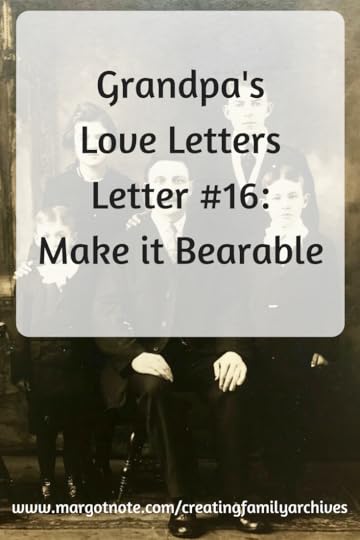
March 5, 2018
‘Speed, Perfection, Cheapness:’ The Ambrotype’s Epoch in Photographic History
I presented this paper at PhotoHistory XV, the 15th Symposium on the History of Photography, on October 21-23, 2011. These symposia are organized by The Photographic Historical Society, the oldest such organization in the world, founded in 1966. During the conference, historians, collectors, photo experts, and dealers from around the world meet at the George Eastman House, the International Museum of Photography & Film in Rochester, New York.
Mathew Brady’s 1856 New York Times advertisement declared, “As the magnetic telegraph is to the mail coach in the transmission of intelligence, so is the Ambrotype to the old process of portraiting,” as the method exemplified “speed, perfection, cheapness, three ideas which are peculiarly the characteristics of the modern age.”
Ambrotypes, derived from the Greek word for imperishable, were underexposed or bleached collodion negatives that, when viewed on dark backgrounds, appeared as positive images. Presented in sizes and cases analogous to daguerreotypes, ambrotypes were less expensive than this earlier process and, correspondingly, integral in expanding photography’s commercialism. As ambrotypes required little skill and small investment, even the poor could afford to have their visage memorialized—a remarkable achievement for a nascent technology.
However, ambrotypes had a depreciated value in their apogee, as some photographers believed the technique lacked the crisp contrast of daguerreotypes. Reflecting the sentiments of some of his contemporaries, photographer J.H. Fitzgibbon wrote in 1861 that ambrotypes were a “black cloud,” with “ghastly, dead, inanimate, flat…shadows” that “must in time die out without any other exertion than their own selves.” The ambrotype’s popularity with itinerant photographers, rather than plushly appointed daguerreotypists, may have also contributed to its downmarket connotation.
Disparagement against collodion positives has continued within contemporary photographic history surveys that treat ambrotypes with short shrift. Although their zenith was brief, lasting from the mid-1850s when they superseded daguerreotypes to the mid-1860s when tintypes and other processes supplanted them, ambrotypes served a salient role in democratizing photography for enamored Victorians.
This presentation examines the ambrotype’s history and evolution, patent and trademark controversies, and cultural responses, conceding the ambrotype’s rightful place in photographic history as the first commercially viable means to document the world.
March 4, 2018
Letter #15: Without One More Kiss
I'm continuing my series of scanning, transcribing, and annotating my grandfather's love letters to my grandmother leading up to their marriage in June 1940. The letters are chronologically organized and preserved, using the methods I discuss in detail in my book, Creating Family Archives: How to Preserve Your Papers and Photographs.
The 15th letter in the Grandpa's Love Letters series raises some questions.
First, what was the arrangement of the rooms in the boarding house? I had originally thought that Ray, Otto, and Fred had separate rooms in the same house. In this letter, though, it seems like Grandpa has the single bed for the night. What were the other options? Perhaps there was a double bed too, so sleeping alone was a treat that was rotated among the three of them.
Also, what caused Grandpa to apologize for the kiss he gave Grandma? Perhaps he could tell that she was embarrassed that her stepbrother, Joe, saw it.
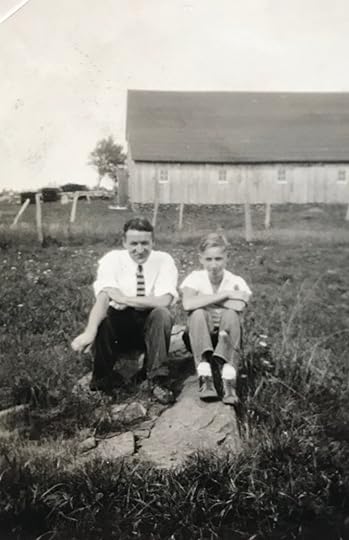
Ray and Joe in the 1930s
Here's a picture of my Grandpa and Joe together in (I'm assuming) Paterson. I'm dating this from the 1930s because of the ages; Joe looks like a young teenager here. A number of these images have remnants of black paper on the back. I'm assuming that these pictures were originally pasted into my Grandma's scrapbook, and she later removed the pictures from it.
Scrapbooks can be an archivist's nightmare. Often they contain mixed-media (paper, photos, ephemera, newsprint), use glue and adhesives, and are made of non-archival materials. Despite their preservation problems, scrapbooks allow creators to make their own narrative, to arrange photos in a meaningful way, and to provide captions. I really wish my Grandmother had kept her scrapbook as is. I wonder why she decided to remove the photos later on?
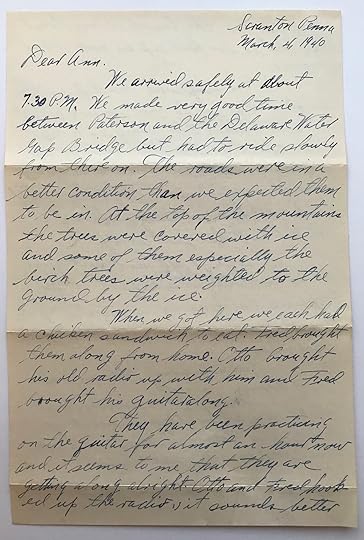
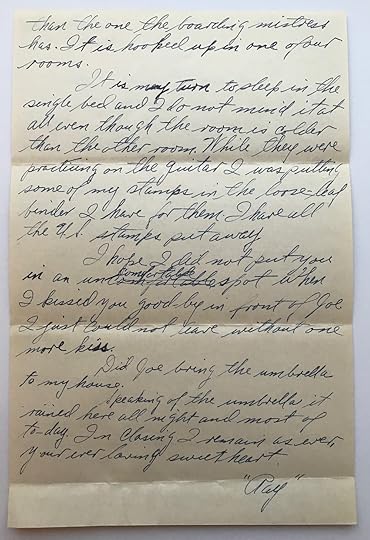
***
Scranton Penna
March 4, 1940
Dear Ann,
We arrived safely at about 7.30 P.M. We made very good time between Paterson and the Deleware Water Gap Bridge but had to ride slowly from there on. The roads were in a better condition than we expected them to be in. At the top of the mountains the trees were covered with ice and some of them especially the birch trees were weighted to the ground by the ice.
When we got here we each had a chicken sandwich to eat. Fred brought them along from home. Otto brought his old radio up with him and Fred brought his guitar along.
They have been practicing on the guitar for almost an hour now and it seems to me that they are getting along alright. Otto and Fred hooked up the radio; it sounds better than the one the boarding mistress has. It is hooked up in one of our rooms.
It is my turn to sleep in the single bed and I do not mind it at all even though the room is colder than the other room. While they were practicing on the guitar I was putting some of my stamps in the loose-leaf binder I have for them. I have all the U.S. stamps put away.
I hope I did not put you in an uncomfortable spot when I kissed you good-by in from of Joe. I just could not leave without one more kiss.
Did Joe bring the umbrella to my house.
Speaking of the umbrella it rained here all night and most of to-day. In Closing I remain as ever, your ever loving sweetheart.
"Ray"
***
To learn the preservation secrets used by libraries, archives, and museums to protect their priceless materials (that you can also use for your family heritage items), read my book:
Creating Family Archives: How to Preserve Your Papers and Photographs
By Margot Note
If you like archives, memory, and legacy as much as I do, you might consider signing up for my email list. Every few weeks I send out a newsletter with new articles and exclusive content for readers. It’s basically my way of keeping in touch with you and letting you know what’s going on. Your information is protected and I never spam.
Ready to get started creating your family archives? Here are some of my favorite products:
Follow me on Pinterest | Instagram | Twitter | LinkedIn | Facebook
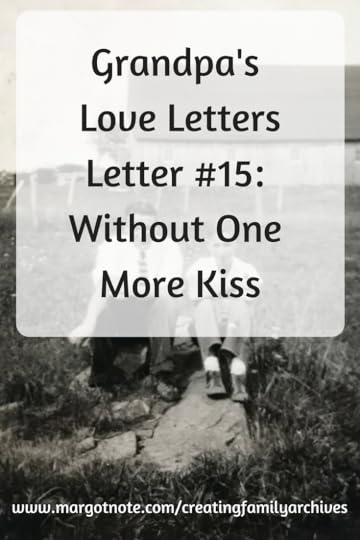
March 2, 2018
March's Webinar: Organize What's Meaningful to You
Back by popular demand! My last webinar was so much fun that I'm doing it again.
Everyone collects a lifetime of papers, photographs, and mementos that tell the stories of their lives. This is our "stuff."
When I talk to people about organizing their stuff, I hear repetitively, "I want to get organized, but I feel so overwhelmed!" I know the feeling of finding messes that seem so daunting that I didn't even know where to begin. But organizing your stuff doesn't have to be daunting. We just need a plan of action to make our efforts achievable.
I've created a webinar to explain the easy steps you can take to organize and preserve what's meaningful and important to you. The focus is on family and personal items--like papers, photographs, and audio-visual items--but the methods I discuss can be used for organizing anything. Feel calmer and less stressed knowing that your stuff is in order and you can find everything you need.
Tickets are only $5 until 3/11/18!
What this webinar offers:
Tips and tricks archivists use to preserve materialsWays to get quicker, easier, affordable results to organzing your stuffWays to approach an overwhelming organizational project so that it's manageableReal-world examples of how to approach organizational projectsGenerous Q&A time so that I can answer all your questionsFollow-up materials to help you get startedExclusive access to a private Facebook group to support your effortsLearn tips and techniques right from the comfort of your computer, so grab your seat for Wednesday, March 21, 2018 from 8:00 PM – 9:00 PM EST. Won't you join me?
Register for the webinar here.
If you like archives, memory, and legacy as much as I do, you might consider signing up for my email list. Every few weeks I send out a newsletter with new articles and exclusive content for readers. It’s basically my way of keeping in touch with you and letting you know what’s going on. Your information is protected and I never spam.
To learn the preservation secrets used by libraries, archives, and museums to protect their priceless materials (that you can also use for your family heritage items), read my book:
Creating Family Archives: How to Preserve Your Papers and Photographs
By Margot Note
Ready to get started creating your family archives? Here are some of my favorite products:
Follow me on Pinterest | Instagram | Twitter | LinkedIn | Facebook
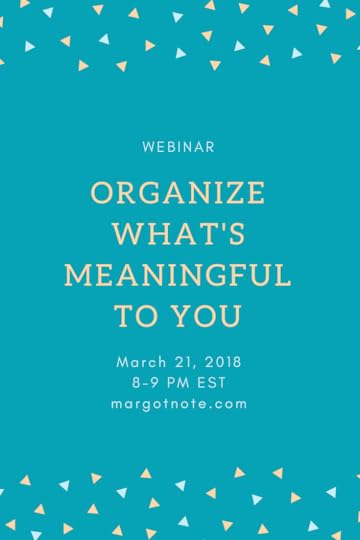
February 26, 2018
Letter #14: Introducing Adolph
I'm continuing my series of scanning, transcribing, and annotating my grandfather's love letters to my grandmother leading up to their marriage in June 1940. The letters are chronologically organized and preserved, using the methods I discuss in detail in my book, Creating Family Archives: How to Preserve Your Papers and Photographs.
The 14th letter in the Grandpa's Love Letters series is quotidian. With each letter, I expect to find a hidden meaning, a beautiful turn of phrase, or some insight into my grandparents as young people, lovers, and individuals.
When I read a letter that's mundane--about the weather, traveling back to Paterson for the weekend, and my grandfather's corns, for Pete's sake--I am disappointed. I have to remind myself that letters in the 1940s weren't the same as they are now. We write letters today to say something important. Some letters in the 1940s bore people's souls, but they often expressed day-to-day matters too. This letter, especially, reminds me of how we use text messages. Grandpa is basically asking Grandma "where u at?" for the upcoming Friday night.
[image error]
Adolph Note from around this period. "Scranton, PA" is written on the back but crossed off. This porch looks similar to the porch that my grandparents had in Scranton, so I'm confused. This image may also be from Paterson, NJ.
This letter mentions my grandfather's father, Adolph Note. Adolph (often spelled Adolf) was born on March 21st, 1880, making him 60 at the time of this letter. He worked at a dyer at the Auger & Simon Silk Dyeing Company in Paterson, NJ. He traveled back and forth from Belgium to New Jersey several times. For example, he first arrived in America at age 25 in 1905 from Moerkerke, Belgium. He arrived again in 1909 on the Lusitania, four years before it sank.
By the time that my grandfather was born, Adolph was naturalized and a saloon keeper. He owned the Lafayette Bar and Grill in Paterson, NJ. After he sold it, the bar became infamous as the site of a triple-homicide that Rubin "Hurricane" Carter was wrongfully convicted of committing.
Adolph's obituary noted that he was a retired stationary fireman and was a member of the Belgian Circle. The Belgian Circle was a social group of Belgian-Americans. I asked my uncle once what community projects they did, and he said, "They just drank!"
I found Adolph's grave in Fair Lawn.
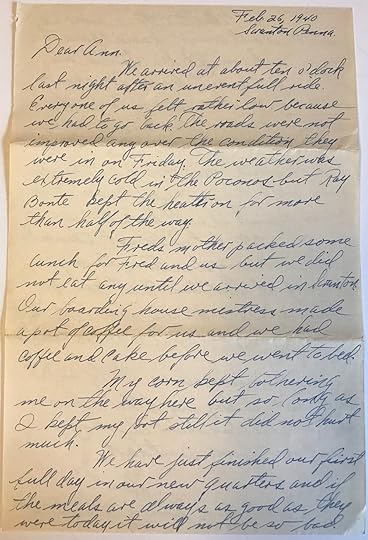
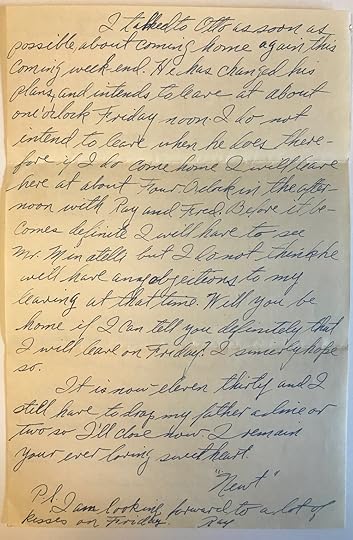
***
Feb. 26, 1940
Scranton Penna.
Dear Ann,
We arrived at about ten o'clock last night after an uneventfull (sic) ride. Every one of us felt rather low because we had to go back. The roads were not improved any over the condition they were in on Friday. The weather was extremely cold in the Poconos but Ray Bonte kept the heater on for more than half of the way.
Fred's mother packed some lunch for Fred and us but we did not eat any until we arrived in Scranton. Our boarding house mistress made a pot of coffee for us and we had coffee and cake before we went to bed.
My corn kept bothering me on the way here but so long as I kept my foot still it did not hurt much.
We have just finished our first full day in our new quarters and if the meals are always as good as they were today it will not be so bad.
I talked to Otto as soon as possible about coming home again this coming week-end. He has changed his plans, and intends to leave at about one o'clock Friday noon. I do not intend to leave when he does therefore if I do come home I will leave here at about Four O'clock in the afternoon with Ray and Fred. Before it becomes definite I will have to see Mr. Minatelli but I do not think he will have any objections to my leaving at that time. Wil you be home if I can tell you definitely that I will leave on Friday? I sincerely hope so.
It is not eleven thirty and I still have to drop my father a line or two so I'll close now. I remain your ever loving sweetheart.
"Newt"
P.S. I am looking forward to a lot of kisses on Friday. Ray.
***
To learn the preservation secrets used by libraries, archives, and museums to protect their priceless materials (that you can also use for your family heritage items), read my book:
Creating Family Archives: How to Preserve Your Papers and Photographs
By Margot Note
If you like archives, memory, and legacy as much as I do, you might consider signing up for my email list. Every few weeks I send out a newsletter with new articles and exclusive content for readers. It’s basically my way of keeping in touch with you and letting you know what’s going on. Your information is protected and I never spam.
Ready to get started creating your family archives? Here are some of my favorite products:
Follow me on Pinterest | Instagram | Twitter | LinkedIn | Facebook

Preserve Your Travel Memories
At its best, a travel memoir documents not only the writer's journey to a destination, but also how that place changed his or her life. The account is as much about foreign travel as it is about the writer's inner self. What I most appreciate about my travels is not the souvenirs, but how the experiences have shaped me as a person: business trips to London and Paris; conferences at Oxford, Durham, and Cardiff; punk shows in Toyko, Bremen, and Hamburg; romantic getaways to Amsterdam, Toronto, and Montreal. Memoirs chronicle life's journeys.
For family historians, travel documents like passports, diaries, photographs, telegrams, postcards, and mementos record the trips of loved ones. While I discuss the ways to protect these materials in my book, Creating Family Archives: How to Preserve Papers and Photographs, I also want to help people forge memories--now, in the present--that they can pass on to others.
I've crafted a travel memory workbook with 30 questions to capture family memories about their travels. The questions are crafted to give you more than yes or no answers and are tailored to uncover information about your loved ones. You can ask family members about their favorite trips, or use it yourself to write the next Eat, Pray, Love.
Interested in my other oral history kits? You can also download:
300+ Personal History Questions Workbook
Family History for Mothers Kit
Family History for Fathers Kit
50+ Halloween Memory Questions
Enter your name and email address to gain access to 30 Travel Memory Questions, as well as a subscription to my newsletter:
To learn the preservation secrets used by libraries, archives, and museums to protect their priceless materials (that you can also use for your family heritage items) read my book:
Creating Family Archives: How to Preserve Your Papers and Photographs
By Margot Note
Ready to get started creating your family archives? Here are some of my favorite products:
Follow me on Pinterest | Instagram | Twitter | LinkedIn | Facebook
